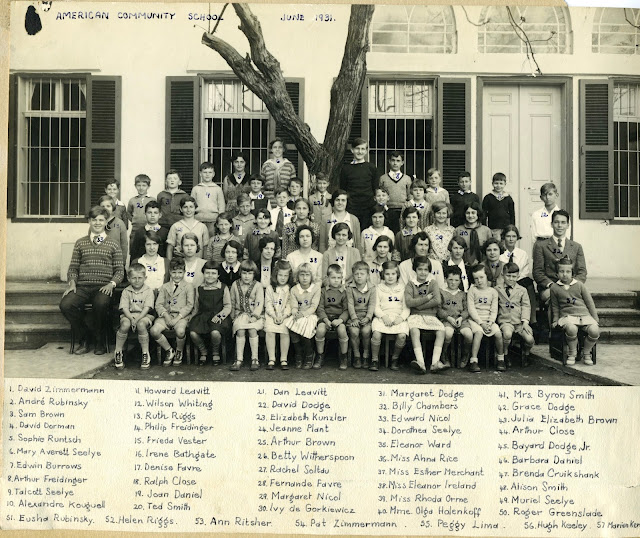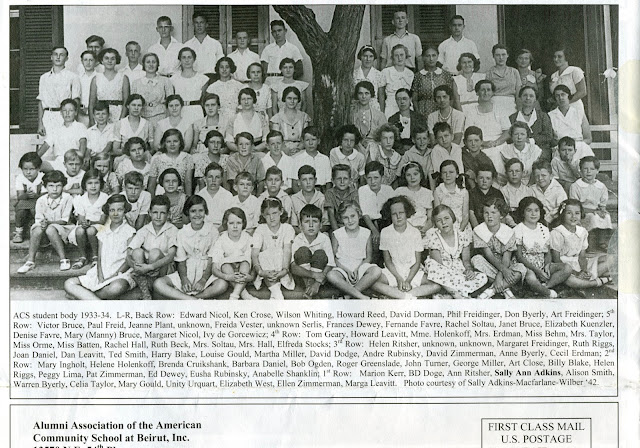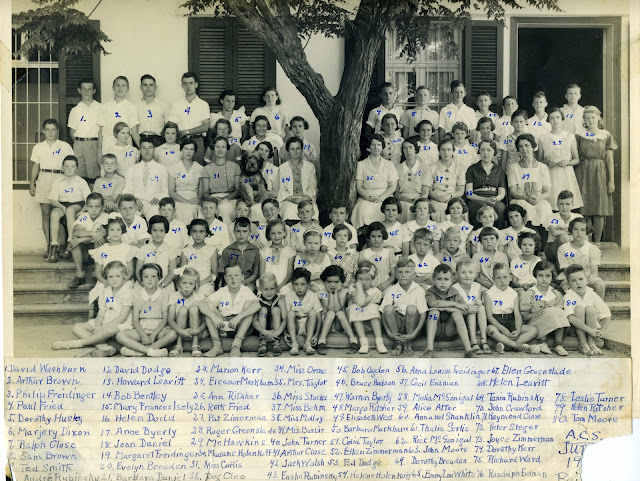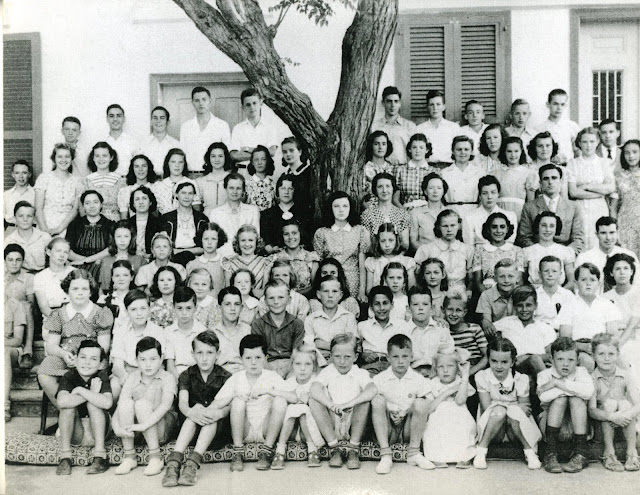Here are a few recollections of ACS's early years by several denizens of Ainab and the American community, copied from the wonderful Al-Mashriq site
In his recollections of the old Faculty School of the "Good Old Days," Mr. Archie Crawford '18 gives us these intimate glimpses of the Old Faculty School:
"For a number of years a beginning class was formed only in alternate years. The class ahead included Dan Bliss '16, Leonard Moore, Marjorie Webster, John West. My brother Forrest entered two years after me, with Amy Moore, Norman Joly, Ralph Patch10, Henry Day, etc.
"For one year I went to school in the ground floor of the Dorman House (where now there is the Idriss Building, on the corner of Bliss and Abdul-Aziz streets). Then we moved to a one-story old house, on the hospital grounds corner opposite the present Faculty Apartment House, which later was home for overseas nurses, and later the hospital maids. The building was torn down when the underground parking lot was begun. "I think in 1922, with a gift from Mrs. Howard Bliss, the building on Artois Street (about 75 meters east of the Khalidy Hospital) was acquired or purchased. There was a big yard on the north reaching to the little Khalidy Street. The little dirty lane, muddy and pools of water, and a cactus hedge on the north, was the present hospital road. People used to throw garbage and dead cats there, and we called it "Stink Lane."
"We had no science courses whatsoever. One year my program included only English, French, German, Latin and Greek (math too?). During World War I, the school shrank. One year my class included only myself and my cousin Frank West. "In April, 1917, the U.S. entered the war, but only broke relations with Turkey. The Turkish Wali of Beirut, Asmi Bey, closed S.P.C. (and I presume ACS closed too) for two weeks, until our Ambassador in Istanbul got the government in Istanbul to approve its re-opening.
"We used to play in the yard extending north to the Eye (later Medical) Pavilion. I remember once we were throwing knives to try to stick them in a big fig tree trunk, and Gus Freyer threw his knife too hard so that it bounced back and stuck itself in his calf. That finished that game for us! We asked to have a big skipping rope, and one day I was coming down when Frank was coming up, and his head hit my mouth and broke off half of my upper front tooth; I think the missing piece is still in his skull. "We boys used to play in the Marquand House garden, and Dr. Moore's house, later the American Embassy, and our house out beyond the old tram line. It's a dilapidated house now, but with two stories and a yard all around. We used to have a kind of annual Field Day in the Marquand tennis courts and we boys cast little medals of lead in some soft white stone like the "Malta stone"
Dr. Jessup used to carve the models of the first set of S.P.C. buildings, set on an artificial hill, with little trees, etc. The medals were sewn to ribbons, and we carved the event on the back of each medal. We used to go swimming, with at least one man and one lady, to the Staff Cove (now the swimming place, just south of the Medical Cove (now Long Beach) and the Prep Cove (now Bain Militaire). The Staff Cove was used for many years by S.P.C. and AUB for their Annual Swimming Contests."
[The following is extracted from Legacy to Lebanon (1986) by Grace Dodge Guthrie '32, who was a student at ACS].
"Our school had no more than forty of fifty pupils of all ages. In eleventh grade my best friend and I were the only students. At recess we relished the danger of walking on top of the six-inch wide school wall. Once I fell off the highest point over a gateway and had to be sent home with an earache. All the students played Prisoner's Base or skipped over a long rope turned by two older boys. The girls hopscotched in a shady corner of the yard, kicking a piece of marble. A fig tree beckoned us to climb its spreading branches.
"One year an unpleasant French lady taught us embroidery. She used to bring her Russian wolfhound into the classroom. He made puddles on the floor. One day after school a couple of teachers decided to clean out a large closet placed high up on the wall of this room. One of them climbed a ladder and started to throw old rugs out. As they hit the floor, hundreds of bloated cockroaches scuttled in all directions. What an uproar! "One of my earliest recollections of school is the day when, in a temper, I slapped the head of a schoolmate, Cathy Nicol, during recess. The incident had already slipped my memory when the principal opened the door of my classroom and called my name. I felt so ashamed as she led me by the hand through the small auditorium used as a study hall, that when I saw Cathy lying on a couch in the dark hallway, I thought she was dying. Hardest of all was being ordered to apologize to her. That pretty well cured me of hitting others.
"Our favorite was the French teacher, Olga Holenkoff. During the Russian Revolution she had escaped with her young husband Georges through the back gate of their garden in Russia. They suffered many hardships on the long trek south and finally settled in the White Russian colony in Beirut. Extraordinarily charming and patrician, with the figure and carriage of a dancer, she was a great lover of life and people. She enlivened her classes with fascinating true stories of her childhood in the Urals, constantly admonishing us to speak only French. Although she was lax in grammar, she taught us all to speak the French language. Every spring she took all her students on a glorious 'French picnic' in the country.
"Besides providing excellent groundwork in the basic subjects, our teachers made time for everyone to act, sing and work on crafts projects. One of my early teachers showed us how to stamp the blue Greek Key design on unbleached cotton curtains for our classroom. She also taught us how to make papyrus, soap, and dipped candles. I can't recall any of the pupils not enjoying school. Most of us adjusted easily to American schools and colleges afterwards."
[The following was written in October 1992 by Kenneth L. Crose '34 who was a student, and later a teacher, at ACS].
Data for the relative student size of ACS during the periods mentioned below has been obtained by comparing the number of students and faculty shown in the several school pictures which I have in my possession. The number is approximate as some pupils or teachers might have been absent on the day the picture was taken:
1924-25 43 pupils 9 teachers
1925-26 30 pupils 3 teachers
1928-29 44 pupils 6 teachers
1929-30 36 pupils 5 teachers
1931-32 52 pupils 6 teachers
1932-33 65 pupils 8 teachers
1933-34 69 pupils 11 teachers
1941-42 29 pupils 7 teachers
1942-43 26 pupils 0 teachers
When our family arrived in Beirut at the end of the summer of 1923, we settled into the ground floor of a house on the northwest intersection of Rue Jeanne d'Arc and Shari'a Sidani. The second building from the corner was the home of ACS during all the time I was acquainted with the school from 1923 to 1944. The property extended between Shari'a Sidani and Shari'a Khalidi. The building was a three-story one extending along the south portion of the property. The gate from Shari'a Sidani was the one the day students and the boarding students used. The gate opening on to Shari'a Khalidi was not used during my first few years as a student. Later it was to be the only entrance for the day students. The school yard between the building and the north wall was of dirt with a large fig tree at the north end and several bushes including a pomegranate on the west side.
The building crowded to the walls on the east and west. On the west there was only a foot or two of room where we kids could squeeze through if we were chasing each other. This was blocked for a while by a castor tree which would explode its pods and shoot beautiful red and black beans through the windows of the classroom on the northwest corner. The gate at the east end of the south wall opened onto a walkway which ran along the east side of the building to the playground. The entire property was surrounded by a sandstone wall some six feet high. It did not have jagged glass inserted along the top as some walls in the area had. The top was flattish sandstone blocks and cement mortar and at times we kids would play tag running around along the top! I do not recall anyone falling off and breaking bones, but I do know that in time we were forbidden to enjoy this game. The stairs to the dormitory began at the corner near that north gate, went halfway up to the second floor on the outside, and then through a door and up the second half into the second floor hallway. To the left was first the kitchen, then the dining room, and then the Dorm Mother's room. Across from her room in the northwest corner was a large living room for the boarding house family. On the north side of the hall, stairs went up to the third floor which had residence rooms. In the ground floor was the school. We entered the building on the north side of the northeast corner onto what might be a room except it did not have a north wall. This made a good place for plays and other activities to take place. At the time there were only enough students for alternate grades. The two younger grades had the first two rooms on the south side of the east-west hallway. In the center of the building was the usual Dar which extended from the south to the north wall. It was converted into a study hall/assembly hall. Opening off this were two rooms used as classrooms for the upper grades.
As enrollment grew, an addition was made to add classrooms and dorm rooms. The exact year when this was done I do not know, but it was in the late twenties, for the 1929-30 school picture was taken against the ell's west wall. Also, I remember having General Science in the room which was created out of the old entrance area when the new wing was added. A hall on the west side of the wing gave access to the three new classrooms. This wing made the building into an L- shape. The ell had only two stories of rooms while the third story was covered with a tile roof, but open on three sides. It was used for drying the washing and recreation for the boarders. The second story had rooms for boarders and teachers. The reasons I have gone in to detail about the building is to back up the conclusion that the more than two decades with which I was associated with ACS I knew it to have a boarding department. I can recall names of students from Palestine, Turkey, Cyprus, northern Syria, and even surrounding villages like Suq al-Gharb and Brumanna. Another addition was made also about this time. In memory of Kenneth Close, who died at an early age, Professor and Mrs. Close had a cement-floored, roofed-over recreation area constructed just northwest of the steps which led down from the study hall.....
[The following was provided in 1993 by Curtis Strong, who was the Principal of ACS from 1940 to 1941]
"I was a teacher of English, History and Social Studies from 1938 to 1941, also serving as Principal my last year. Miss Rhoda Orme was Principal from, I think, 1932 to 1940 when, along with some other teachers and students, she left for the States.
"In mid-May 1941, I was called to a meeting in the office of President Bayard Dodge of the AUB, along with the heads of American Missionary and other organizations. Dr. Dodge described German infiltration into Lebanon and Syria, and told those at the meeting that he had secret intelligence that British and Free French forces in Palestine were planning a pre-emptive invasion. All Americans who wished to were being advised to evacuate. American schools were to be closed as quickly as possible.
"Returning to the school, I called an Assembly and informed the students that school was over for the year. Jubilation reigned. I also formed teams of students to pack and mark everything so that the school could be reopened without confusion. The students set to with a will, and did a wonderful job. The teachers completed report cards for every student. Within a day or two, a convoy of private cars left Beirut for Jerusalem. It was such an impressive caravan, with the lead car flying an American flag, that French Indo-Chinese guard units along the way snapped to attention, much to the delight of the children. The vicissitudes of the long trip home via Jerusalem, Cairo and various sea routes is another story."
Strong closes his report with the following: "One other accomplishment, if a different sort, of my years at ACS was the year (1940?) that our basketball team, which I coached, was the runner-up in the Lebanese secondary school championship. We played mostly teams of older, larger boys, but made up for it in quickness, ball-handling and spirit. Mainstays on the team were Bill Stoltzfus, Art Close, Ed Dewey and Dave Wharton. I'm sorry I've forgotten the other member of the starting five. I've also forgotten the name of the Lebanese team that beat us in the finals, but I do remember they were big and our boys put up a good fight. The game was played on the AUB field down on the Corniche."
Class pictures
Contributed by Frances Dodd (daughter of Peter Dodd) and Steve Peters (son of Marga Leavitt Peters)
1931. Includes the Rubinsky, Dorman, Seelye, Leavitt, Close, Smith, Dodge, Holenkoff, and Cruikshank families.
1932. Includes: Dodges, Seelyes, Dorman, Holenkoffs, Smiths, Leavitts, Zimmermann, Closes, Riggs, Liz West, Rubinskys, Brenda Cruikshank, as labelled.
1933? As labelled.
1937. Bottom row: Bruce Dodd and Malcolm Kerr; 2nd row: Peter Dodd and Ray Close; 3rd row: Johnny Crawford; 6th row at left: Marga Leavitt and Liz West.
1938. Font row: Malcolm Kerr and Bruce Dodd; Row 2/3: Ray Close and Peter Dodd.










What a magnificent post. So full of history, personal accounts and wonderful photos.
ReplyDeleteThis comment has been removed by the author.
ReplyDeleteHi Josh! My brother Johnny Peet was a pal of yours. It's so great to see your Blog...it'll be fabulous to read. I'm curious to know if you were in contact with the late Børre Ludvigsen, who wrote a history of ACS (which I have yet to see). He and I compiled three books of stories by ACSers...with some old timers contributing. Do you know about those? Thanks for this work you're doing...I appreciate it. I LOVED going to Ainab with the Gordons!! ~Anne Peet Carrington (class of '70)
ReplyDeleteDear Anne, Lovely to get this message from you and wonderful to hear about the books that you and Borre compiled. I do not know them, alas.
DeleteI did follow Borre's work when it was on-line and he was curating his wonderful site. I never met him or spoke with him, alas.
I would love to catch up with your brother, Johnny. We were inseparable in 4th grade and spent all our time at recess together. He was the person from ACS that I missed the most when we left Beirut in 1967.
Oh...but now I see that it's Al Mashriq..Børre's fantastic site!
ReplyDeleteYes, this was copied from Borre's wonderful site.
Delete